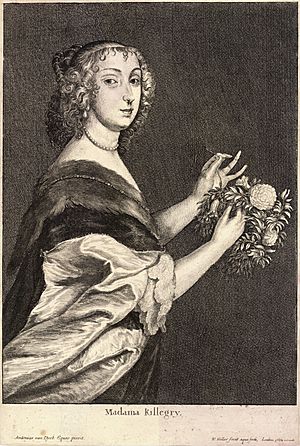Cecilia Crofts facts for kids
Cecilia Crofts (died 1638) was an important lady at the English royal court. She was a "maid of honour" to Queen Henrietta Maria. This meant she was a close attendant to the Queen. Cecilia was also the subject of several poems written by famous poets of her time.
Contents
Who Was Cecilia Crofts?
Cecilia Crofts was the sixth daughter of Sir John Crofts (1563-1628). Her family lived in Little Saxham, Suffolk. Her mother was Mary Shirley, daughter of Sir Thomas Shirley of Wiston. Cecilia's oldest brother was Henry Crofts.
Early Court Life and Masques
The family home at Little Saxham was sometimes visited by King James I. In February 1620, Cecilia and her seven sisters planned a special performance for the King. It was a type of play called a "masque." Masques were popular shows with music, dancing, and costumes.
Another masque was performed for the King in December 1621. A script for one of these masques still exists. It is called "The Vision of the Nine Goddesses." Cecilia and her sisters, including Dorothy, Lady Bennet, and Anne Crofts, Lady Wentworth, played the goddesses. An actor playing Apollo introduced each goddess with a song.
A Royal Rumour
Around this time, a rumour spread about King James I and Cecilia. A writer named Simonds d'Ewes heard that the King had secretly married "Sissilia Crafts." King James had given one of Sir John Croft's unmarried daughters a valuable necklace. It was worth £500, which was a lot of money back then. This gift was given on Shrove Tuesday in 1620. Many believed this daughter was Cecilia.
However, King James denied the rumour in March 1622. He joked that he was "King of the most lying nation in the world."
Business Ventures
In 1631, Cecilia Crofts was involved in a business dispute. She wanted to gain control of the income from four coal mines. These mines were located in Benwell, near Newcastle upon Tyne. Her brother Anthony Crofts and Lord Goring helped her. Cecilia successfully won her case. The other person involved, Richard Forster, had to make a deal with Sir Peter Riddell, who owned the mines.
A Life of Art and Poetry
Cecilia Crofts was also involved in the arts. In 1633, she performed in a masque called The Shepheard's Paradise. This masque was written by Walter Montagu and performed at Somerset House.
Several poets wrote about Cecilia. Sir Robert Ayton wrote a poem called Upon Platonic Love: To Mistress Cicely Crofts: Maid of Honour. This poem might be connected to the ideas in Montagu's masque. Another famous poet, Sir John Suckling, wrote To Mrs Cicely Crofts. In his poem, he praised her beauty and spirit.
Marriage and Later Life
In 1636, Cecilia married Thomas Killigrew. He was a courtier and a playwright. His parents were Robert Killigrew and Mary Woodhouse.
Thomas Killigrew later wrote about a song called Jealousy: A Dialogue. He said that Thomas Carew, a gentleman of the king's court, wrote it. Carew supposedly wrote the song after seeing Cecilia and Thomas argue before their wedding. The song was performed in a masque at Whitehall Palace in 1633. Killigrew later included this poem in his own play, Cicilia and Clorinda, published in 1664. Carew also wrote a poem for their wedding day, called On the Marriage of T. K. and C. C., the morning stormie.
Cecilia's nephew was William Crofts. He was known as "mad cap Crofts." He worked for Queen Henrietta Maria, managing her horses. Sadly, his brother was shot in a duel in France in 1644. The person who shot him was Jeffrey Hudson, the Queen's court dwarf.
Cecilia Crofts died on January 1, 1638. She left behind a son named Henry or Harry Killigrew. He was born on April 16, 1637. Henry later married Mary Savage, daughter of John Savage, 2nd Earl Rivers. He passed away in 1705.
Legacy and Remembrance
A famous artist named Anthony van Dyck painted Cecilia's portrait. This portrait was later made into an engraving by Wenceslaus Hollar.
After her death, a poet named Francis Quarles wrote a special poem. It was called Sighes at the contemporary deaths of those incomparable sisters, the Countesse of Cleaveland, and Mistrisse Cicily Killegrue. This poem remembered Cecilia and her sister, the Countess of Cleveland.


